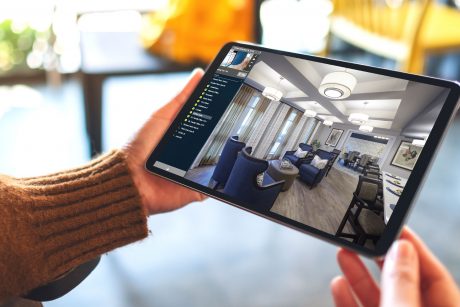By Sarah Daniels
Planning ahead is never easy, but in the world of senior living construction, acquisitions and renovations, it makes everything that follows easier — and often more cost effective in the long term. The need to future-proof seniors housing has taken on new significance in the face of COVID-19 and will continue to be a priority to help prospective and current residents feel safe physically, mentally and emotionally. With seniors housing occupancy rates down, creating a strong, upfront plan for long-term goals incorporating trends in design, wellness and technology will be critical in creating long-term community growth.

Gaurie Rodman,
Direct Supply Aptura
Gaurie Rodman, director of Development Services at Direct Supply Aptura, explains that operators and investors want buildings to be renovated in a manner that meets current needs but does not lose sight of future opportunities. “Inserting a planning phase into a project allows for all vested parties — owners, operators, funders, etc. — to align on the scope of work and project costs. While most project goals are aligned, sometimes needs may contradict each other, have different levels of priorities or face conditions that may not allow for a project to be executed as envisioned. The planning stage allows the team to investigate these conditions and develop a plan that balances all needs of the project to meet its financial goals. Doing this ultimately will save time and money,” says Rodman.
Planning Services
“The planning phase is intended to align all those desires for how the building performs to support consumer demand and operational excellence in a financially sustainable model.” Meeting a client’s financial goals and timeline are most important to Aptura in the planning stage of a project, explains Rodman.
Part of this planning is understanding the marketplace. Many people understand what needs to happen inside their own buildings, but Gaurie indicates that Aptura’s approach is to consider what is happening in terms of the broader marketplace — including demographics, niche markets and overall competition in the area.
“When you’re doing a capital investment, you’re putting dollars into brick and mortars that have to meet today’s consumer needs as well as your needs within a five-to-10-year period. We know that, historically, senior living buildings get remodeled every seven to 10 years. That means that whatever capital investment you put in must be able to adapt to a shifting marketplace need,” says Rodman.
This is also the stage to first consider technology: HVAC systems (particularly those aimed at indoor air quality control), real-time location systems for advanced visibility into a community, Wi-Fi needs and building infrastructure are all essential considerations that, if left to the last minute, can be harder and more expensive to incorporate.
The only way to ensure communities can adapt is to plan. Otherwise, Rodman points out, one can wind up wasting money in an industry where one cannot afford to misuse funds or misstep on a communities’ value proposition post-pandemic.
Acquisitions: Balance and Considerations for the Future
Rodman predicts there will be an increase in acquisitions post-pandemic as operators come to terms with the challenges of a post-COVID-19 world for their communities. As increased awareness of healthcare needs, higher regulations and simple burnout take operators out of the picture, there will be a rebalancing of the marketplace.
This is a pivotal time for senior living, which took a perception hit with the arrival of COVID-19. Yet the clear need for healthy, purposeful aging environments could not be more evident. As investors look at acquisitions, they need to be laser focused on their capital investments in communities. In the pre-closing/due diligence phase, Rodman recommends taking the time to not only investigate the property’s CapEx needs, but to also evaluate the market opportunity to ensure that there’s the appropriate capital for ROI investments and to maximize the market opportunity.
Pre-closing, one has the opportunity to consider what consumers may demand and what staff will need in the future. Rodman points out that as staffing concerns continue, the importance grows for optimizing how employees use an existing building — creating technologically enabled buildings, remote monitoring systems, automatic doors and more.
Interiors Assessments & Interior Design: Meshing with Technology

Erin Berry,
Direct Supply Aptura
When it comes to interior design, the importance of a strong, guiding strategy cannot be overstated. Erin Berry, director of Interior Design at Direct Supply Aptura, explains that when one discusses these renovations, what’s really at stake is planning how a community will function, balanced with the communities’ CapEx dollars and investments. “Planning and understanding what your current situation is at your community can help you put together individualized plans for how to renovate your spaces and how to use some of that investment in a smarter way.”
At Aptura there is a big emphasis on talking to the residents and staff to see what kind of renovations are needed, but also how to safely get things back to normal. “We think there will need to be considerations and alterations for buildings for the kind of future-proofing needed for things like a pandemic. Unfortunately, we don’t think this is going to be the last pandemic. So, the question becomes: how can interior assessments and design add to the functional safety of the community?”
Berry suggests engaging technology and layout together as a first line of defense. Thermal temperature scanners or touchscreens in entryway vestibules create a framework where a digital check-in is required before entering. Entrances can be re-envisioned to allow safe visitation spaces and discourage nonresidents from traversing through the entire community during cold and flu season. Dining room reservation systems and satellite dining can keep residents safer (especially when implemented in conjunction with new entrance and exit paths that avoid crowding).
Many of these changes — especially incorporating more outdoor elements (e.g., for dining or outdoor meeting areas) or providing access to sunlight, fresh air and biophilic design can enhance wellness without requiring a large amount of capital expenditure.
As communities plan their next interior design renovation projects, it will be important to consider the next wave of seniors housing interior design. Adaptability and incorporating technology will be key. Some of the newest and most exciting technologies Direct Supply Aptura works with are SafelyYou, an AI-enabled camera system. The technology detects resident falls and provides data that can help inform resident room design strategies, resulting in up to 40 percent fewer falls.*
The COVID-19 pandemic also highlighted the need for strong video surveillance and overall visibility into senior living communities. Some technologies offer all-in-one solutions, like CenTrak’s TruView, a real-time location system that includes people and asset tracking and helps with operational efficiency, contact tracing, emergency response services and more. Other approaches use a mix of elements (including technology and existing spaces) to support wellness and engagement: Wi-Fi, electronics and flexible socialization spaces (like A/V theater rooms, sunrooms, salons and activities rooms) can all be used in conjunction to promote health.
— By Sarah Daniels. This sponsored content was written in conjunction with Direct Supply.
Learn more about Direct Supply Aptura’s planning program here.
* Aggregated data from facilities prior to and after implementing the SafelyYou solution during a 32-week period in 2019-2020. Individual and community results will vary based on a variety of factors.

